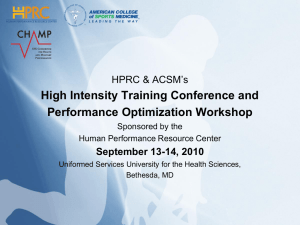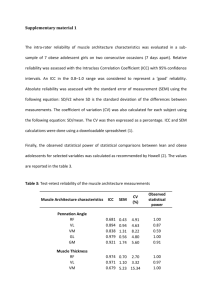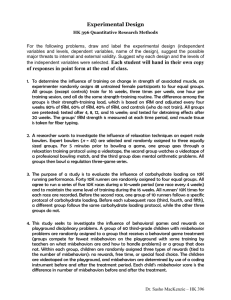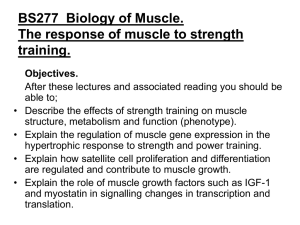Reliability of the one-repetition maximum test based on muscle
advertisement
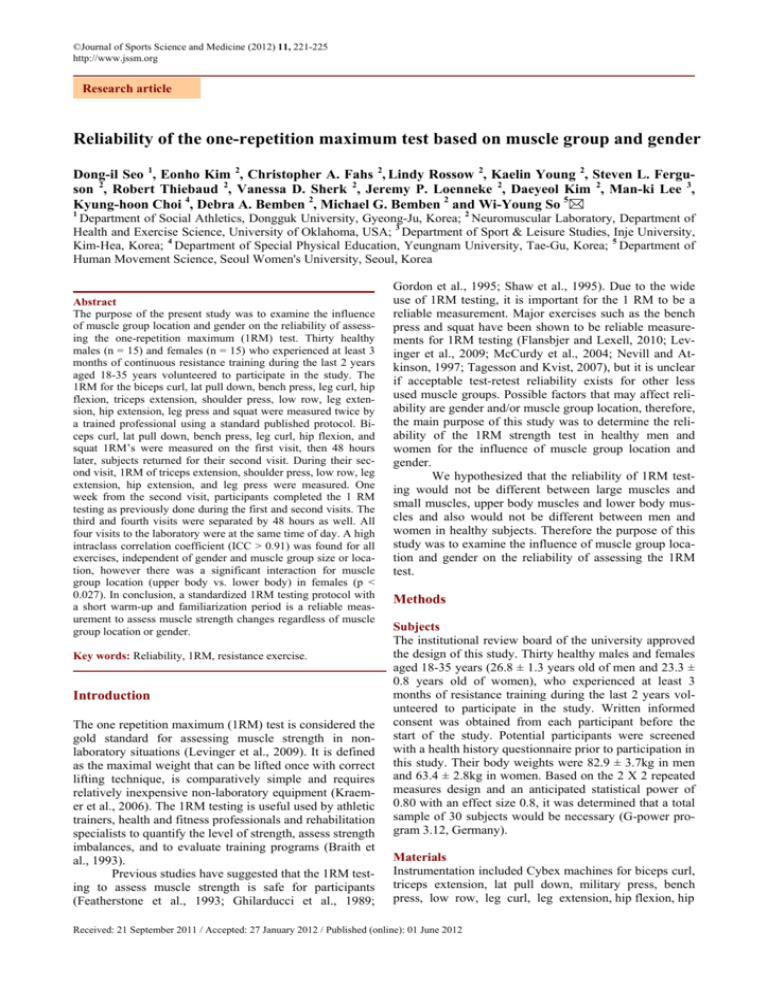
©Journal of Sports Science and Medicine (2012) 11, 221-225 http://www.jssm.org Research article Reliability of the one-repetition maximum test based on muscle group and gender Dong-il Seo 1, Eonho Kim 2, Christopher A. Fahs 2, Lindy Rossow 2, Kaelin Young 2, Steven L. Ferguson 2, Robert Thiebaud 2, Vanessa D. Sherk 2, Jeremy P. Loenneke 2, Daeyeol Kim 2, Man-ki Lee 3, Kyung-hoon Choi 4, Debra A. Bemben 2, Michael G. Bemben 2 and Wi-Young So 5 1 Department of Social Athletics, Dongguk University, Gyeong-Ju, Korea; 2 Neuromuscular Laboratory, Department of Health and Exercise Science, University of Oklahoma, USA; 3 Department of Sport & Leisure Studies, Inje University, Kim-Hea, Korea; 4 Department of Special Physical Education, Yeungnam University, Tae-Gu, Korea; 5 Department of Human Movement Science, Seoul Women's University, Seoul, Korea Abstract The purpose of the present study was to examine the influence of muscle group location and gender on the reliability of assessing the one-repetition maximum (1RM) test. Thirty healthy males (n = 15) and females (n = 15) who experienced at least 3 months of continuous resistance training during the last 2 years aged 18-35 years volunteered to participate in the study. The 1RM for the biceps curl, lat pull down, bench press, leg curl, hip flexion, triceps extension, shoulder press, low row, leg extension, hip extension, leg press and squat were measured twice by a trained professional using a standard published protocol. Biceps curl, lat pull down, bench press, leg curl, hip flexion, and squat 1RM’s were measured on the first visit, then 48 hours later, subjects returned for their second visit. During their second visit, 1RM of triceps extension, shoulder press, low row, leg extension, hip extension, and leg press were measured. One week from the second visit, participants completed the 1 RM testing as previously done during the first and second visits. The third and fourth visits were separated by 48 hours as well. All four visits to the laboratory were at the same time of day. A high intraclass correlation coefficient (ICC > 0.91) was found for all exercises, independent of gender and muscle group size or location, however there was a significant interaction for muscle group location (upper body vs. lower body) in females (p < 0.027). In conclusion, a standardized 1RM testing protocol with a short warm-up and familiarization period is a reliable measurement to assess muscle strength changes regardless of muscle group location or gender. Key words: Reliability, 1RM, resistance exercise. Introduction The one repetition maximum (1RM) test is considered the gold standard for assessing muscle strength in nonlaboratory situations (Levinger et al., 2009). It is defined as the maximal weight that can be lifted once with correct lifting technique, is comparatively simple and requires relatively inexpensive non-laboratory equipment (Kraemer et al., 2006). The 1RM testing is useful used by athletic trainers, health and fitness professionals and rehabilitation specialists to quantify the level of strength, assess strength imbalances, and to evaluate training programs (Braith et al., 1993). Previous studies have suggested that the 1RM testing to assess muscle strength is safe for participants (Featherstone et al., 1993; Ghilarducci et al., 1989; Gordon et al., 1995; Shaw et al., 1995). Due to the wide use of 1RM testing, it is important for the 1 RM to be a reliable measurement. Major exercises such as the bench press and squat have been shown to be reliable measurements for 1RM testing (Flansbjer and Lexell, 2010; Levinger et al., 2009; McCurdy et al., 2004; Nevill and Atkinson, 1997; Tagesson and Kvist, 2007), but it is unclear if acceptable test-retest reliability exists for other less used muscle groups. Possible factors that may affect reliability are gender and/or muscle group location, therefore, the main purpose of this study was to determine the reliability of the 1RM strength test in healthy men and women for the influence of muscle group location and gender. We hypothesized that the reliability of 1RM testing would not be different between large muscles and small muscles, upper body muscles and lower body muscles and also would not be different between men and women in healthy subjects. Therefore the purpose of this study was to examine the influence of muscle group location and gender on the reliability of assessing the 1RM test. Methods Subjects The institutional review board of the university approved the design of this study. Thirty healthy males and females aged 18-35 years (26.8 ± 1.3 years old of men and 23.3 ± 0.8 years old of women), who experienced at least 3 months of resistance training during the last 2 years volunteered to participate in the study. Written informed consent was obtained from each participant before the start of the study. Potential participants were screened with a health history questionnaire prior to participation in this study. Their body weights were 82.9 ± 3.7kg in men and 63.4 ± 2.8kg in women. Based on the 2 X 2 repeated measures design and an anticipated statistical power of 0.80 with an effect size 0.8, it was determined that a total sample of 30 subjects would be necessary (G-power program 3.12, Germany). Materials Instrumentation included Cybex machines for biceps curl, triceps extension, lat pull down, military press, bench press, low row, leg curl, leg extension, hip flexion, hip Received: 21 September 2011 / Accepted: 27 January 2012 / Published (online): 01 June 2012 222 Reliability of strength assessment extension, leg press, and squat (Lumex, Ronkonkoma, NY, USA). Procedures On the initial visit, participants signed the informed consent form, and completed a physical activity questionnaire. Following an individual warm-up of stationary cycling and a brief familiarization with the equipment, 1RM for the biceps curl, lat pull down, bench press, leg curl, hip flexion, and squat were measured by a trained professional. Forty-eight hours after the first visit, subjects returned for their second visit. During their second visit, their 1RM of triceps extension, shoulder press, low row, leg extension, hip extension, and leg press were measured. One week from the second visit, participants completed the 1 RM testing as previously done during the first and second visit. The third and fourth visits were separated by 48 hours as well. All four visits to the laboratory were at the same time of day. 1RM strength testing Participants warmed up prior to testing by cycling for 5 minutes on a stationary bicycle. After a 1 minute rest period, participants were familiarized with each of the resistance machines (Lumex, Ronkonkoma, NY, USA) by performing 8-10 repetitions of a light load (~50% of predicted 1RM). After a 1 minute of rest, participants performed a load (~80% of estimated 1RM) through the full range of motion. After each successful performance, the weight increased until a failed attempt occurred. One minute rests were given between each attempt and the 1RM was attained within 5 attempts and 5 minutes rest separated each test. In order to facilitate the recovery and reduce the effect of fatigue, exercises were alternated between the upper and lower body. The order of the exercises during the first visit was as follows: biceps curl, leg curl, lat pull down, hip flexion, chest press, and squat. The order of the exercises during the second visit was as follows: triceps extension, leg extension, shoulder press, hip extension, low row, and leg press. All 1RM measurements were reported in kilograms for subsequent data analysis. We also defined large and small muscle groups by 1RM weight that is to say 1RM of Lat pull down, Bench press, Low row, Leg extension, Leg press, Squat were heavier than others. Statistical analysis The data were analyzed using SPSS 17.0 software (SPSS, INC., Chicago, IL, USA) for windows. In this study, the reliability was performed according to the recommendation of two published papers (Atkinson and Nevill, 1998; Hopkins, 2000). The coefficient of variation (CV) was defined as the ratio of the standard deviation to the mean. Also intraclass correlation coefficient (ICC) was used as they are a common measurement of reliability that enables comparisons with other study (Atkinson and Nevill, 1998). ICC method was based on a repeat measurement of maximal strength and in which the same investigator conducted each test (Portney and Watkins, 2000). Differences between men and women were analyzed by means of repeated-measures ANOVA. Paired sample t-test was performed for examining difference between test and retest. Descriptive data are presented as means and standard error of the means. A p value of p < 0.05 was accepted as the level of statistical significance for all variables. Results Raw data of test and retest for all twelve exercises of 30 subjects are showed in Table 1. Also the interaction of gender X time for muscle strength is presented in Table 1. We found that there were no differences between males and females on reliability of the 1RM tests. Table 2 shows the reliability of test retest in males, females, and for the combined sample. A high intraclass correlation coefficient (ICC > 0.91) was found for all exercises. Table 3 shows the interaction of muscle groups (upper body vs. lower body, large muscles vs. small muscles) X time for muscle strength test. There was a significant interaction effect on muscle group location (upper body vs. lower body) in females (p < 0.027). Discussion In the current study, our main findings showed that the 1RM test, using Cybex exercise equipment, is a reliable and simple method for assessing maximum strength for both men and women and for a wide range of large and small muscle groups. However, there was a significant interaction for the upper body muscle groups versus lower body muscle groups in females (p < 0.027). Table 1. Interaction of gender ⅹ time for muscle strength. Data are means (± SEM, kg). Male Female F Test Retest Test Retest 56.2 (4.7) 56.2 (4.7) 18.0 (2.1) 18.2 (2.1) .104 Biceps curl 49.0 (3.7) 49.0 (3.7) 19.3 (1.9) 19.5 (1.9) 1.000 Triceps extension 74.5 (3.3) 78.7 (5.4) 36.1 (2.8) 36.3 (2.8) 1.099 Shoulder press 88.3 (4.5) 87.0 (4.8) 40.9 (3.3) 41.0 (3.4) 2.422 Lat pull down 95.5 (5.0) 98.9 (6.7) 42.0 (2.8) 42.0 (2.8) 1.000 Low row 98.6 (7.5) 98.0 (7.2) 39.3 (2.9) 39.3 (2.9) .944 Bench press 81.3 (3.5) 82.7 (3.6) 54.5 (4.7) 55.2 (4.8) .341 Hip flexion 111.2 (1.3) 111.2 (1.3) 80.8 (4.1) 80.6 (4.1) 1.000 Hip extension 102.2 (3.3) 102.3 (3.2) 59.0 (4.5) 59.8 (4.5) 1.068 Leg curl 102.0 (4.1) 102.5 (4.0) 60.9 (3.6) 61.3 (3.6) .152 Leg extension 159.2 (9.7) 159.2 (9.6) 103.5 (5.6) 104.1 (5.6) .483 Leg press 116.8 (10.6) 116.2 (10.3) 52.1 (5.2) 54.0 (5.5) 2.033 Squat Tested by two-way mixed factorial repeated measures ANOVA for gender x time p .749 .326 .304 .131 .326 .340 .564 .326 .310 .699 .493 .165 Seo et al. 223 Table 3. Interaction of muscle group (upper body vs. lower body; large muscles vs. small muscles) x time for muscle strength. Data are means (± SEM, kg). Male Female Test Retest Test Retest 77.0 (2.8) 78.0 (3.0) 32.6 (1.5) 32.7 1.5) Upper body 112.2 (3.6) 112.4 (3.5) 68.5 (2.7) 69.2 (2.7) Lower body .570 4.959 F .451 .027* p 110.1 (3.8) 110.3 (3.9) 56.4 (2.9) 57.0 (2.9) Large muscle 79.1 (2.7) 80.0 (2.8) 44.6 (2.8) 44.9 (2.8) Small muscle .574 .610 F .450 .436 p Upper body muscle groups: Biceps curl, Triceps extension, Shoulder press, Lat pull down, Low row, Bench press; Lower body muscle groups: Hip flexion, Hip extension, Leg curl, Leg extension, Leg press, Squat; Large muscle groups: Lat pull down, Bench press, Low row, Leg extension, Leg press, Squat; Small muscle groups: Biceps curl, Triceps extension, Shoulder press, Hip flexion, Hip extension, Leg curl. * p < 0.05. Tested by two-way mixed factorial repeated measures ANOVA for muscle group x time. Table 2. The reliability of test and retest in male, female, and total. Test Male Female Total (n=15) (n=15) (n=30) Biceps curl CV .325 .64 ICC .993** .996** .998** Triceps extension CV .30 .55 ICC 1.000** .995** 1.000** Shoulder press CV .22 .44 ICC .644** .998** .913** Lat pull down CV .205 .44 ICC .979** .998** .995** Low row CV .23 .48 ICC .836** 1.000** .961** Bench press CV .29 .535 ICC .997** 1.000** .999** Hip flexion CV .17 .31 ICC .969** .996** .992** Hip extension CV .05 .20 ICC 1.000** .999** 1.000** Leg curl CV .12 .325 ICC .998** .994** .998** Leg extension CV .155 .31 ICC .997** .994** .999** Leg press CV .235 .315 ICC .997** .997** .998** Squat CV .345 .53 ICC .992** .973** .994** ICC, intraclass correlation coefficient; CV, coefficient of variation; * p < 0.05, ** p < 0.01 This study is the first to examine the reliability of 1RM testing for a wide range of resistance exercises (twelve exercises), compared to many previous studies that only used major muscle groups (Frontera et al., 1993; Levinger et al., 2009; McCurdy et al., 2004; PloutzSnyder and Giamis, 2001; Tagesson and Kvist, 2007). Flansbjer and Lexell (2010) reported the reliability of 1RM testing on leg extension and leg curl, Levinger et al. (2009) reported the reliability of 1RM testing on chest press, leg press, lat pull down, triceps push down, knee extension, seated row, and, biceps curl. McCurdy et al. (2004) reported the reliability of 1RM testing on squat, Tagesson and Kvist (2007) reported the reliability of 1RM testing on squat and knee extension, with all studies reporting that each 1RM test was reliable. In the current study, we examined the reliability of 1RM testing on upper and lower body and large and small muscle groups in both males and females. Our results suggest that coaches and clinicians can utilize the 1RM testing to reliably monitor the progress of muscle strength in healthy men and women. An important part to ensure reliability in 1RM testing is the use of familiarization. Some previous studies reported that multiple familiarization sessions are needed before assessing maximal strength in order to avoid an improvement in muscle strength due to improved motor coordination or other neural adaptations (Kraemer et al., 2006; Ploutz-Snyder and Giamis, 2001). Also it has been suggested that a familiarization process prior to 1RM strength test is essential for ensuring reliable test results, and minimize learning effects or systematic bias (Frontera et al., 1993; Hopkins, 2000). Our participants were familiarized with each of the resistance machines by performing 8-10 repetitions of a light load (~50% of predicted 1 RM) before the 1RM testing. This short familiarization period may be adequate for assessing maximal strength, since our reliability of the 1RM tests were very good (ICC > 0.91, r > 0.92) for each muscle group and both genders. Interestingly, we found a significant interaction between the upper body versus lower body reliability in the female group (p < 0.027) indicating a slight improvement between the different testing sessions for the lower body muscles compared to the upper body muscles. These results may indicate the need for more familiarization for larger muscle groups in order to ensure a more stable measure since they are more capable of exerting muscle greater forces than the upper body muscles. Practical applications This investigation sought to determine the reliability of a standardized 1RM testing protocol in healthy men and women and for a variety of muscle groups. The results of the current study suggests that the 1RM test is a reliable and simple method to evaluate maximal strength of resistance exercises in healthy men and women and that the 1RM test can be used by athletic trainers, health and fitness professionals and rehabilitation specialists to quantify the level of strength, to assess strength imbalances, and to evaluate training programs. Conclusion 224 In conclusion, a standardized 1RM testing protocol with a short warm-up and familiarization period is a reliable measurement technique to assess muscle strength changes regardless of muscle group location or gender. Acknowledgments This work was supported by Dongguk University Special Fund for the new faculty member (2012). References Atkinson, G. and Nevill, A.M. (1998) Statistical methods for assessing measurement error (reliability) in variables relevant to sports medicine. Sports Medicine 26, 217-238. Braith, R.W., Graves, J.E., Leggett, S.H. and Pollock, M.L. (1993) Effect of training on the relationship between maximal and submaximal strength. Medicine and Science in Sports and Exercise 25, 132-138. Featherstone, J.F., Holly, R.G. and Amsterdam, E.A. (1993) Physiologic responses to weight lifting in coronary artery disease. The American Journal of Cardiology 71, 287-292. Flansbjer, U.B. and Lexell, J. (2010) Reliability of knee extensor and flexor muscle strength measurements in persons with late effects of polio. Journal of Rehabilitation Medicine 42, 588-592. Frontera, W.R., Hughes, V.A., Dallal, G.E. and Evans, W.J. (1993) Reliability of isokinetic muscle strength testing in 45- to 78years-old men and women. Archives of Physical Medicine Rehabilitation 74, 1181-1185. Ghilarducci, L.E.C., Holly, R.G. and Amsterdam, E.A. (1989) Effects of high resistance training in coronary artery disease. The American Journal of Cardiology 64, 866-870. Gordon, N.F., Kohl, H.W., Pollock, M.L., Vaandrager, H., Gibbons, L.W. and Blair, S.N. (1995) Cardiovascular safety of maximal strength testing in healthy adults. The American Journal of Cardiology 76, 851-853. Hopkins, W.G. (2000) Measures of reliability in sports medicine and science. Sports Medicine 30, 1-15. Kraemer, W.J., Ratamess, N.A., Fry, A.C. and French, D.N. (2006) Strength training: development and evaluation of methodology. In: Physiological assessment of human fitness. Eds: Maud P.J. and Foster, C. Champain, IL: Human Kinetics. Levinger, I., Goodman, C., Hare, D.L., Jerums, G., Toia, D. and Selig, S. (2009) The reliability of the 1RM strength test for untrained middle-aged individuals. Journal of Science and Medicine in Sport 12 (3), 310-316. McCurdy, K., Langford, G.A., Cline, A.L., Doscher, M. and Hoff, R. (2004) The reliability of 1- and 3RM tests of unilateral strength in trained and untrained men and women. Journal of Sports Science and Medicine 3, 190-196. Nevill, A.M. and Atkinson, G. (1997) Assessing agreement between measurements recorded on a ratio scale in sports medicine and sports science. British Journal of Sports Medicine 31, 314-318. Patterson, P., Sharman, J., Hitzelberger, L. and Nichols, J. (1996) Testretest reliability of selected LifeCircuit machines. Journal of Strength and Conditioning Research 10, 246-249. Ploutz-Synder, L.L. and Giamis, E.L. (2001) Orientation and familiarization to 1RM strength testing in old and young women. Journal of Strength and Conditioning Research, 15, 519-553. Portney, L.G. and Watkins, J.B. (2000) Foundations of clinical research: applications to practice. Upper Sddle River, NJ: Prentice Hall Health. Shaw, C.E., MaCully, K.K. and Posner, J.D. (1995) Injuries during the one repetition maximum assessment in the elderly. Journal of Cardiopulmonary Rehabilitation 15: 283-287. Tagesson, S.K. and Kvist, J. (2007) Intra- and interrater reliability of the establishment of one repetition maximum on squat and seated knee extension. Journal of Strength and Conditioning Research 21 (3), 801-807. Reliability of strength assessment Key points • The one repetition maximum (1RM) test is consider ed the gold standard for assessing muscle strength in non-laboratory situations. • This study was done to examine the influence of muscle group location and gender on the reliability of assessing the 1RM test. • The standardized 1RM testing protocol with a short warm-up and familiarization period is a reliable measurement technique to assess muscle strength changes regardless of muscle group location or gender AUTHORS BIOGRAPHY Dong-il SEO Employment Assistant Professor, Department of Social Ath letics, Dongguk University, Korea Degree PhD E-mail: bmw930@dongguk.ac.kr Eonho KIM Employment Department of Health and Exercise Science, University of Oklahoma Degree MSc E-mail: eonkim@ou.edu Christopher A. FAHS Employment Department of Health and Exercise Science, University of O klahoma Degree MSc E-mail: chris.fahs@ou.edu Lindy ROSSOW Employment Department of Health and Exercise Science, University of Oklahoma E-mail: lindy.rossow@ou.edu Kaelin YOUNG Employment Department of Health and Exercise Science, University of O klahoma Degree MSc E-mail: kcyoung@ou.edu Steven L. FERGUSON Employment Department of Health and Exercise Science, University of O klahoma Degree MSc E-mail: Steven.L.Ferguson-1@ou.edu Robert THIEBAUD Employment Department of Health and Exercise Science, University of O klahoma Degree MSc E-mail: Robert.S.Thiebaud-1@ou.edu Seo et al. Vanessa D. SHERK Employment Department of Health and Exercise Science, University of O klahoma Degree MSc E-mail: vanessa.sherk@ou.edu Jeremy P. LOENNEKE Employment Department of Health and Exercise Science, University of O klahoma Degree MSc E-mail: jploenneke@ou.edu Daeyeol KIM Employment Department of Health and Exercise Science, University of Oklahoma Degree MSc E-mail: dykim@ou.edu Man-ki LEE Employment Department of Sport & Leisure Studies, Inje University Degree PhD E-mail: spelmk@inje.ac.kr Kyung-hoon CHOI Employment Department of Special Physical Education, Yeungnam University Degree PhD E-mail: ckhunjk@hanmail.net Debra A. BEMBEN Employment Professor, Department of Health and Exercise Science, Univ ersity of Oklahoma Degree PhD E-mail: dbemben@ou.edu Michael G. BEMBEN Employment Professor, Department of Health and Exercise Science, University of Oklahoma Degree PhD E-mail: mgbemben@ou.edu Wi-Young SO Employment Assistant Professor, Department of Human M ovement Science, Seoul Women's University, Seoul, Korea Degree PhD E-mail: wowso@swu.ac.kr Wi-Young So, PhD Assistant Professor, Department of Human Movement Science, Seoul Women's University, Seoul, Korea 225
